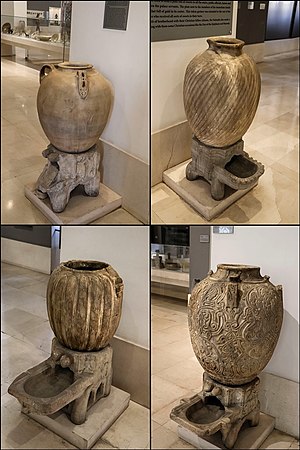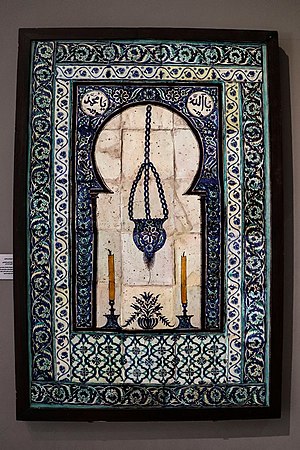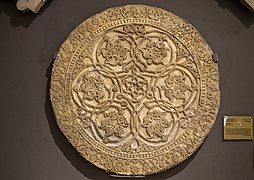Museum of Islamic Art (Cairo)
The Museum of Islamic Art in Cairo , Egypt , is one of the most important museums of its kind in the world. This includes an extraordinary collection of rare woodwork, as well as metal, ceramic, glass, crystal and textile objects from all eras and regions of the Islamic world.
The museum also carried out archaeological excavations in the Fustāt area and organized a variety of national and international exhibitions. The museum closed for renovation in 2003 and reopened 8 years later in August 2010. The restoration cost nearly US $ 10 million.
history
As early as 1858, the governor of the Ottoman province of Egypt, Ismail Pasha , supported a proposal to set up a museum for Islamic art in the courtyard of the Baibars mosque . This proposal was not implemented until 1880, when Khedive Muhammad Tawfiq took over the Ministry of Religious Affairs ( Arabic الأوقاف Awqaf ) instructed to carry out the plans.
In 1881, Julius Franz , an Austrian architect and head of the technical department of the ministry, suggested that the ruins of the mosque of the Fatimid caliph al-Hakim , located next to the city gate Bab Al-Futuh , be set up as a temporary seat for the museum. To this end, a gallery was set up in the eastern arcade, initially showing 111 architectural exhibits from other monuments.
In the same year Khedive Tawfiq appointed a "Committee for Arab Antiques", whose task was to manage the Arab Museum. This also included the procurement of exhibits and the preservation of the monuments. As a result, the arcades were no longer overcrowded. In 1884, a two-story building was built in the courtyard to enable the exhibition of around 900 objects, although only a curator and a porter were available as employees.
In 1887, Max Herz , an Austro-Hungarian , replaced Julius Franz and began numerous changes. He suggested the then name of the museum as a gallery for Arabic antiquities ( Arabic دار الآثار العربية Dar Al-Athar Al-Arabiya ). In 1895 the collection already comprised 1641 objects and the new building became too narrow. So he asked the Awqaf to build a larger museum. In 1899 the foundation stone was laid for a larger building in the Bab Al-Khalq area of Cairo.
The new and current building was designed by Alfonso Manescalo and built in 1902 in a neo- Mamluk style. The old building in al Hakim was demolished in the 1970s.
Museum building
The museum building is oriented towards the old town of Cairo. It has two entrances; one on the northeast, the other on the southeast. A beautiful garden with a fountain once led to the first entrance but was later removed. The entrance on Port Said Street features a luxurious facade with rich decorations, which is inspired by Islamic architecture from different epochs of Egypt. The museum is a two-story building. The ground floor contains the exhibition rooms, the upper floor the Egyptian National Library . In the basement there are storage rooms that are connected to a renovation workshop.
Bomb damage
On January 24, 2014, the museum was badly damaged and numerous artifacts were destroyed by a car bomb targeting the police headquarters opposite. It is estimated that around 20-30% of the objects needed restoration. The explosion also damaged the facade of the museum building and destroyed valuable design elements in the Islamic style. The Egyptian National Library , located in the same building, was also affected.
The museum reopened in January 2017.
collection
In recent years, the museum has displayed around 4,500 artifacts in 25 rooms. The entire collection, however, comprises over 100,000 objects, some of which are not on display in warehouses. The oldest objects come from the Umayyad period in the 7th century, the youngest from the Ottoman Empire in the 19th century.
The collection includes finds from Egypt, North Africa, al-Andalus , the Arabian Peninsula and Iran from the 7th to 19th centuries. The objects on display in the right wing of the museum are divided into the Umayyad, Abbasid, Ayubid, Mamluk and Ottoman periods. The objects on display in the museum's left wing are divided into sections based on science, astronomy, calligraphy, coins, stones, and textiles.
The collection includes rare manuscripts of the Koran , including copies with calligraphy in silver ink and preciously ornamented pages.
Web links
Individual evidence
- ^ Cairo Blast Rips Into Islamic Art Museum, Damaging Key Global Collection . 2014 ( nationalgeographic.com ).
- ^ Cairo's Islamic Art Museum bombed. BBC News, 2014, accessed October 24, 2017 .
- ↑ Unesco to assess blast damage at the Islamic museum in Cairo . In: The Guardian . 2014 ( theguardian.com ).
- ^ Paul-Anton Krüger: Save what can be saved. In: Süddeutsche Zeitung. January 22, 2017 ( sueddeutsche.de ), accessed October 6, 2017.
- ^ Martin Gehlen: Egypt reopens the Museum of Islamic Art. In: Badische Zeitung. January 25, 2017 ( badische-zeitung.de ), accessed on October 6, 2017.
Coordinates: 30 ° 3 ′ 0 ″ N , 31 ° 22 ′ 0 ″ E








